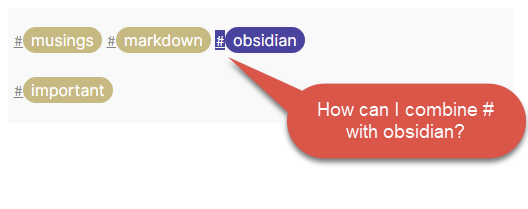Use case or problem
I’d like to add context-sensitive color to nested tags in both preview and edit mode.
It is possible to style non-nested tags by using a CSS selector such as this: (for a tag #project)
.tag[href^="#project"],
.cm-s-obsidian span.cm-hashtag-begin.cm-tag-project, .cm-s-obsidian span.cm-hashtag-end.cm-tag-project
This works in both edit and preview mode.
HOWEVER this breaks down when nested tags are used. The nested tag #project/test-project-a is NOT colored by the above rule.
In preview mode the above renders as:
<a href="#project/test-project-a" class="tag" target="_blank" rel="noopener">#project/test-project-a</a>
This is easy to create a CSS selector for because we can just target the beginning of the string:
.tag[href^="#project"]
But we can’t do this in edit mode due to the way edit mode constructs the CSS classes.
This is because the editor embeds the entire tag name as a CSS class in edit mode. Typing the above tag in edit mode renders as the following in edit mode:
<span class="cm-hashtag cm-meta cm-hashtag-end cm-tag-projecttest-project-a">project/test-project-a</span>
As you can see, the only way to color this tag is to modify the CSS snippet every time a new project is created, to add a selector for cm-tag-projecttest-project-a.
Proposed solution
Add each component of a nested tag as a separate CSS class.
Given tag: #foo/bar/baz
Render this in edit mode:
<span class="cm-hashtag cm-meta cm-hashtag-end cm-tag-foo cm-tag-foo-bar cm-tag-foo-bar-baz">project/test-project-a</span>
Notice the tag is split into three separate classes, one for each nesting level. This allows easy selector definition for defining scoped colors in edit mode.
And in preview mode:
<a href="#project/test-project-a" class="tag tag-foo tag-foo-bar tag-foo-bar-baz" target="_blank" rel="noopener">#project/test-project-a</a>
Current workaround (optional)
None.
Related feature requests (optional)
This question has come up several times in various places, for example:
 This now colors tags in both preview AND edit mode, with a single declaration covering both
This now colors tags in both preview AND edit mode, with a single declaration covering both 


